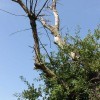Abstract
Urban trees provide shade and beauty, and the urban forest as a whole provides a wealth of benefits to neighborhoods and residents. But stresses from the urban environment may lead to problems that pose an unacceptable safety risk to people and property. It is a landowner’s responsibility to ensure that the trees on their property are safe. A key step in reducing the potential for tree-related injury or property damage is learning to identify common tree defects associated with increased risk of failure. This 5-page fact sheet highlights seven easily recognizable tree defects that homeowners and non-professionals in public agencies may encounter in Florida. Written by Drew C. McLean, Andrew K. Koeser, Robert J. Northrop, and Gitta Hasing, and published by the UF Department of Environmental Horticulture, October 2014. (Photo by Gitta Hasing)
References
Dunster, J. A., E. T. Smiley, N. Matheny, and S. Lilly. 2013. Tree Risk Assessment Manual. Champaign, Illinois: International Society of Arboriculture.
Duryea, M. and E. Kampf, 2014. "Wind and Trees: Lesson Learned from Hurricanes." FOR-118. Gainesville, FL: University of Florida Cooperative Extension Service. http://edis.ifas.ufl.edu/pdffiles/FR/FR17300.pdf.

